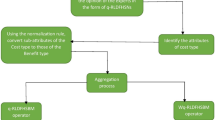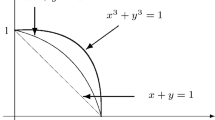Abstract
The objective of this research is to introduce a parametric likelihood measure based on the beta distribution and develop a likelihood-oriented methodology for solving multiple criteria decision analysis (MCDA) problems with Pythagorean fuzzy (PF) sets. With the rapid advancement of PF theory, exploring an effective approach to compare PF information is indispensable in resolving MCDA issues. The beta distribution is one the most commonly used distributions to simulate the theoretical distribution. By changing the parameter values, the beta distribution can generate symmetrical or asymmetrical patterns and various shapes, including flat or steep. Due to its flexibility and adaptability, the beta distribution is able to effectively solve complex real-world problems. To make a major contribution to the technical development of decision support applications, this paper utilizes beta distributions as a parameterization tool to introduce a new parametric likelihood measure for evaluating the outranking relationships among PF information (signified by Pythagorean membership grades). Based on the evolved likelihood-based concepts (e.g., mean outranking indices, weighted outranking grades, and comprehensive outranking measures and indices), this paper proposes a pragmatic PF likelihood-oriented method to prioritize competing alternatives under uncertain and ambiguous Pythagorean fuzzy conditions. To carefully examine the practicality and suitability of the proposed methodology in realistic decision-making environments, this paper utilizes the evolved methods to solve a realistic MCDA problem of selecting pilot hospitals in relation to postacute care. The main results that are generated by the practical application and subsequent experimental analysis and comparative study demonstrate the effectivity and superiority of the developed technique and can be used for practical purposes in flexible and convenient ways. This most important conclusion of this paper is the great aptitude and dominance of the proposed methodology based on the corroboration of the experimental and comparative results of the application. Furthermore, this study has a noticeable originality in the utilization of the generic beta distribution-based approach and the construction of an effective PF likelihood-oriented decision model, which enriches the development of decision-making applications with PF theory.
















Similar content being viewed by others
Data availability
The datasets generated during and/or analyzed during the current study are available from the corresponding author on reasonable request.
References
Akram M, Alsulami S, Zahid K (2021) A hybrid method for complex Pythagorean fuzzy decision making. Math Probl Eng. https://doi.org/10.1155/2021/9915432
Akram M, Ilyas F, Garg H (2021) ELECTRE-II method for group decision-making in Pythagorean fuzzy environment. Appl Intell 51:8701–8719. https://doi.org/10.1007/s10489-021-02200-0
Akram M, Luqman A, Alcantud JCR (2021) Risk evaluation in failure modes and effects analysis: hybrid TOPSIS and ELECTRE I solutions with Pythagorean fuzzy information. Neural Comput Appl 33(11):5675–5703. https://doi.org/10.1007/s00521-020-05350-3
Akram M, Shahzadi G (2021) Decision-making approach based on Pythagorean Dombi fuzzy soft graphs. Granul Comput 6(3):671–689. https://doi.org/10.1007/s41066-020-00224-4
Alshkaki RSA (2021) A six parameters beta distribution with application for modeling waiting time of Muslim early morning prayer. Ann Data Sci 8:57–90. https://doi.org/10.1007/s40745-020-00282-0
Bai Y, Wang H, Wang L, Tian K (2019) Study and analysis on fuzzy quality control for the high-end manufacturing process based on Taguchi quality loss function. J Comput Methods Sci Eng 19(1):121–136. https://doi.org/10.3233/JCM-180857
Büyüközkan G, Göçer F (2021) Evaluation of software development projects based on integrated Pythagorean fuzzy methodology. Expert Syst Appl. https://doi.org/10.1016/j.eswa.2021.115355
Chen T-Y (2019) A novel VIKOR method with an application to multiple criteria decision analysis for hospital-based post-acute care within a highly complex uncertain environment. Neural Comput Appl 31(8):3969–3999. https://doi.org/10.1007/s00521-017-3326-8
Chen T-Y (2021) A likelihood-based preference ranking organization method using dual point operators for multiple criteria decision analysis in Pythagorean fuzzy uncertain contexts. Expert Syst Appl. https://doi.org/10.1016/j.eswa.2021.114881
Chen T-Y (2021) Pythagorean fuzzy linear programming technique for multidimensional analysis of preference using a squared-distance-based approach for multiple criteria decision analysis. Expert Syst Appl. https://doi.org/10.1016/j.eswa.2020.113908
Chen T-Y (2021) The likelihood-based optimization ordering model for multiple criteria group decision making with Pythagorean fuzzy uncertainty. Neural Comput Appl 33:4865–4900. https://doi.org/10.1007/s00521-020-05278-8
Chrysafis KA, Panagiotakopoulos D, Papadopoulos BK (2013) Hybrid (fuzzy-stochastic) modelling in construction operations management. Int J Mach Learn Cybern 4(4):339–346. https://doi.org/10.1007/s13042-012-0093-9
Daddow M, Zhang X, Qiu H, Zhang Z, Liu Y (2020) A mathematical model for ballast tamping decision making in railway tracks. Civ Eng J 6(10):2045–2057. https://doi.org/10.28991/cej-2020-03091601
Deb R, Roy S (2021) A software defined network information security risk assessment based on Pythagorean fuzzy sets. Expert Syst Appl. https://doi.org/10.1016/j.eswa.2021.115383
Dharmapala PS (2014) Randomizing efficiency scores in DEA using beta distribution: an alternative view of stochastic DEA and fuzzy DEA. Int J Bus Anal 1(4):1–15. https://doi.org/10.4018/ijban.2014100101
Díaz B, Morillas A (2011) Incorporating uncertainty in the coefficients and multipliers of an IO table: a case study. Pap Reg Sci 90(4):845–861. https://doi.org/10.1111/j.1435-5957.2010.00341.x
Fei L, Feng Y, Liu L (2019) On Pythagorean fuzzy decision making using soft likelihood functions. Int J Intell Syst 34(12):3317–3335. https://doi.org/10.1002/int.22199
Garg H (2018) New exponential operational laws and their aggregation operators for interval-valued Pythagorean fuzzy multicriteria decision-making. Int J Intell Syst 33(3):653–683. https://doi.org/10.1002/int.21966
Gładysz B (2017) Fuzzy-probabilistic PERT. Ann Oper Res 258(2):437–452. https://doi.org/10.1007/s10479-016-2315-0
Hendiani S, Lev B, Gharehbaghi A (2021) Diagnosing social failures in sustainable supply chains using a modified Pythagorean fuzzy distance to ideal solution. Comput Ind Eng. https://doi.org/10.1016/j.cie.2021.107156
Jalao ER, Wu T, Shunk D (2014) A stochastic AHP decision making methodology for imprecise preferences. Inf Sci 270:192–203. https://doi.org/10.1016/j.ins.2014.02.077
Ji C, Zhang R, Wang J (2021) Probabilistic dual-hesitant Pythagorean fuzzy sets and their application in multi-attribute group decision-making. Cogn Comput 13(4):919–935
Jiang G-J, Chen H-X, Sun H-H, Yazdi M, Nedjati A, Adesina KA (2021) An improved multi-criteria emergency decision-making method in environmental disasters. Soft Comput 25(15):10351–10379. https://doi.org/10.1007/s00500-021-05826-x
Johnson NL, Kotz S, Balakrishnan N (1995) Continuous univariate distributions, vol, 2nd edn. New York, NY: John Wiley & Sons, Inc.
Khalaf TZ, Çağlar H, Çağlar A, Hanoon AN (2020) Particle swarm optimization based approach for estimation of costs and duration of construction projects. Civ Eng J 6(2):384–401. https://doi.org/10.28991/cej-2020-03091478
Liang D, Darko AP, Xu Z, Zhang Y (2020) Partitioned fuzzy measure-based linear assignment method for Pythagorean fuzzy multi-criteria decision-making with a new likelihood. J Oper Res Soc 71(5):831–845. https://doi.org/10.1080/01605682.2019.1590133
Mao H, Cai R (2020) Negation of Pythagorean fuzzy number based on a new uncertainty measure applied in a service supplier selection system. Entropy. https://doi.org/10.3390/e22020195
Mohagheghi V, Mousavi SM, Mojtahedi M, Newton S (2020) Evaluating large, high-technology project portfolios using a novel interval-valued Pythagorean fuzzy set framework: an automated crane project case study. Expert Syst Appl. https://doi.org/10.1016/j.eswa.2019.113007
Mohagheghi V, Mousavi SM, Mojtahedi M, Newton S (2021) Introducing a multi-criteria evaluation method using Pythagorean fuzzy sets: A case study focusing on resilient construction project selection. Kybernetes 50(1):118–146. https://doi.org/10.1108/K-04-2019-0225
Molla MU, Giri BC, Biswas P (2021) Extended PROMETHEE method with Pythagorean fuzzy sets for medical diagnosis problems. Soft Comput 25(6):4503–4512. https://doi.org/10.1007/s00500-020-05458-7
Ng DWW, Koh SK, Sim SZ, Lee MC (2018) The study of properties on generalized beta distribution. J Phys Conf Ser 1132:012080. In: 3rd international conference on mathematical sciences and statistics, 6–8 Feb 2018, Le Meridien Putrajaya, Malaysia. https://doi.org/10.1088/1742-6596/1132/1/012080
Pathan MA, Garg M, Agrawal J (2008) On a new generalized beta distribution. East West J Math 10(1):45–55
Prenga D (2020) General features of the q-XY opinion model. J Hum Earth Future 1(2):87–96. https://doi.org/10.28991/HEF-2020-01-02-05
Rahmani A, Lotfi FH, Rostamy-Malkhalifeh M, Allahviranloo T (2016) A new method for defuzzification and ranking of fuzzy numbers based on the statistical beta distribution. Adv Fuzzy Syst. https://doi.org/10.1155/2016/6945184
Rani P, Mishra AR, Saha A, Pamucar D (2021) Pythagorean fuzzy weighted discrimination-based approximation approach to the assessment of sustainable bioenergy technologies for agricultural residues. Int J Intell Syst 36(6):2964–2990. https://doi.org/10.1002/int.22408
Samokhvalov YY (2018) Development of the prediction graph method under incomplete and inaccurate expert estimates. Cybern Syst Anal 54(1):75–82. https://doi.org/10.1007/s10559-018-0008-1
Tsao C-Y, Chen T-Y (2021) Pythagorean fuzzy likelihood function based on beta distributions and its based dominance ordering model in an uncertain multiple criteria decision support framework. Int J Intell Syst 36(6):2680–2729. https://doi.org/10.1002/int.22398
Wang J-C, Chen T-Y (2020) A novel Pythagorean fuzzy LINMAP-based compromising approach for multiple criteria group decision making with preference over alternatives. Int J Comput Intell Syst 13(1):444–463. https://doi.org/10.2991/ijcis.d.200408.001
Xu T, Zhang H, Li B (2021) Pythagorean fuzzy TOPSIS method based on 2-tuple probability weight. J Intell Fuzzy Syst 40(5):9113–9126. https://doi.org/10.3233/JIFS-201533
Yager RR (2013) Pythagorean fuzzy subsets. In: Proceedings of the 2013 joint IFSA world congress and NAFIPS annual meeting, Edmonton, Canada, 24–28 June, 2013, pp 57–61. https://doi.org/10.1109/IFSA-NAFIPS.2013.6608375
Yager RR (2014) Pythagorean membership grades in multicriteria decision making. IEEE Trans Fuzzy Syst 22(4):958–965. https://doi.org/10.1109/TFUZZ.2013.2278989
Yager RR, Abbasov AM (2013) Pythagorean membership grades, complex numbers, and decision making. Int J Intell Syst 28(5):436–452. https://doi.org/10.1002/int.21584
Yu CH, Liu CC, Chen KS, Yu CM (2020) Constructing fuzzy hypothesis methods to determine critical-to-quality service items. Mathematics. https://doi.org/10.3390/math8040573
Zhang X, Xu Z (2014) Extension of TOPSIS to multiple criteria decision making with Pythagorean fuzzy sets. Int J Intell Syst 29(12):1061–1078. https://doi.org/10.1002/int.21676
Zhou F, Chen T-Y (2020) Multiple criteria group decision analysis using a Pythagorean fuzzy programming model for multidimensional analysis of preference based on novel distance measures. Comput Ind Eng. https://doi.org/10.1016/j.cie.2020.106670
Zhou F, Chen T-Y (2021) An extended Pythagorean fuzzy VIKOR method with risk preference and a novel generalized distance measure for multicriteria decision-making problems. Neural Comput Appl 33(18):11821–11844. https://doi.org/10.1007/s00521-021-05829-7
Acknowledgements
The authors acknowledge the assistance of the respected editor and the anonymous referees for their insightful and constructive comments, which helped to improve the overall quality of the paper. The first author is grateful for grant funding support from Chang Gung Memorial Hospital, Linkou, Taiwan (BMRP 864). The corresponding author is grateful for grant funding support from the Ministry of Science and Technology, Taiwan (MOST 110-2410-H-182-005), and Chang Gung Memorial Hospital, Linkou, Taiwan (BMRP 574), during the completion of this study.
Author information
Authors and Affiliations
Contributions
CYT contributed to methodology, software, validation, formal analysis, writing—original draft, writing—review and editing, and funding acquisition. TYC contributed to conceptualization, methodology, formal analysis, data curation, writing—original draft, visualization, writing—review and editing, and funding acquisition.
Corresponding author
Ethics declarations
Conflict of interest
The authors declare that they have no known competing financial interests or personal relationships that could have appeared to influence the work reported in this paper.
Human or Animal Rights
This article does not contain any studies with human participants or animals that were performed by any of the authors.
Additional information
Publisher's Note
Springer Nature remains neutral with regard to jurisdictional claims in published maps and institutional affiliations.
Rights and permissions
About this article
Cite this article
Tsao, CY., Chen, TY. A parametric likelihood measure with beta distributions for Pythagorean fuzzy decision-making. Neural Comput & Applic 34, 13757–13806 (2022). https://doi.org/10.1007/s00521-022-07151-2
Received:
Accepted:
Published:
Issue Date:
DOI: https://doi.org/10.1007/s00521-022-07151-2




